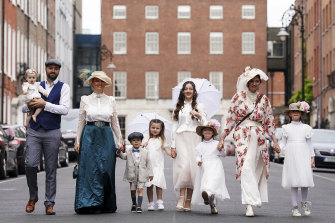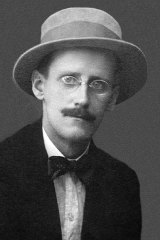
When it was first published by Sylvia Beach from her famous Parisian bookshop, Shakespeare and Company, in February 1922, it immediately fell foul of obscenity laws around the world and was roundly denounced, banned, censored and burnt.
That the story not only survived but went on to be one of the most read and unread books of all time must be a testament to something. What was I missing?

Great-grand nieces and nephews of Irish writer James Joyce at the Bloomsday celebrations.Credit:AP
I bought the novel (again) four weeks before Bloomsday itself and sought the counsel of friends, acquaintances and the internet on how to tackle it now that I was older, wiser and desperate not to look like a total fool in Dublin (this last proving a surprisingly efficacious stimulus).
Advice ranged from listening to it as an audiobook (an Irish accent helps, to be sure), not taking it too seriously, starting at chapter 4, skipping the boring bits, reading a chapter a week, reading a chapter a year, reading it all in 24 hours, reading it out loud, reading it while drunk and reading it out loud while drunk.

Ulysses novelist James Joyce.Credit:Getty Images
To those not in the know, Ulysses is set on one day – June 16, 1904 – and concerns two men, Leopold Bloom and Stephen Dedalus, as they go about their lives. It starts in a Martello tower in Sandycove just outside Dublin city and ends in the early hours of the next day after the two men get rip-roaringly drunk.
It is a book exceptional for its time, as academic, author and Joyce scholar Declan Kiberd writes in the introduction to my edition, in “cleaving to the quotidian”. After all, here were characters shown urinating, defecating, masturbating, having sex and farting.
On Bloomsday, at the top of the Martello tower that Joyce once stayed in and later used in the first chapter, volunteer guide Seamus Cannon, resplendent like many others on Bloomsday in a beige linen suit, bowtie and straw boater, put it thus: “He [Joyce] took the bread of life and consecrated it into art.”
He also gave headaches and feelings of intellectual inadequacy to generations of would-be readers (though that might just be me) who couldn’t get their head around the stream-of-consciousness style and the lack of punctuation.
It helps to know that Joyce was attempting to recreate on the page how the way the brain works in real life. Imagine how your mind wanders during just a few seconds – all the chitter-chatter of everyday life and shards of memory and of thoughts thought, examined, discarded – and you’ll have an idea of what reading Ulysses entails.
It helps, as someone on an online comments section put it, to have “a comprehensive education in English literature from Anglo-Saxon to the 19th century and an acquaintance with early Continental modernism and the classics” to appreciate and understand it.
A bit of Latin and a thorough grounding in Irish history, Catholicism and politics wouldn’t go amiss, either. And let’s not even get started on the fact that the book is Joyce’s interpretation of Homer’s Odyssey, with Leopold Bloom’s wanderings through Dublin standing in for Odysseus’s 10-year journey home to Ithaca after the Trojan Wars. In fact, forget I mentioned it.
Bloomsday, itself, began in 1954 when a few local literary luminaries decided to celebrate the book by getting together to recreate it. That first Bloomsday ended in drunkenness and recriminations, but a tradition was born that has turned into an event celebrated around the world. That sound you can hear is Shakespeare turning in his grave.
My Bloomsday begins at the James Joyce Centre, where I have inveigled an invite to the official Bloomsday breakfast. Here, the great and the good of Dublin (it is kicked off by Irish politician Catherine Martin, who exults in the positively Joycean title of Minister for Tourism, Culture, Arts, Gaeltacht, Sport and Media) are dressed to the nines in Edwardian garb – like many other Ulysses nuts throughout the city – to watch a troupe of actors perform excerpts from the book.
I also meet a man from Philadelphia who has been studying Ulysses via Zoom meetings and has flown over from the USA to meet his fellow pupils. They started reading it in February and have just finished. One well-timed bomb here, I think, would wipe out most of the people in the world who have read the whole of Ulysses.
Loading
After this, we head off on a walking tour with guide Loic Wright, whose erudition and heavily annotated and bookmarked copy of the book (his last one fell apart at the seams) help trace the Dublin of Ulysses over modern Dublin.
Bloomsday is busy. The city is awash with people in period dress-up, following in Bloom’s footsteps. They head en masse to Davy Byrne’s restaurant for a gorgonzola sandwich and a glass of burgundy, a la Bloom. They queue massively outside Sweny’s former chemist to buy, a la Bloom, a scented lemon soap. There are kidneys for breakfast on many menus, a la Bloom.
They, like us, head to the Martello tower to stand on the top and gaze at people diving off the rocks below into what Joyce called the “snotgreen” and “scrotumtightening” sea.
Gradually it begins to rub off – all the discussions and the listening and the orations and the performances – and starts to make weird sense. This was Joyce going where nobody had gone before. He was experimenting with interior monologues, making up words, pushing boundaries.
There are passages of pure beauty, genius even. And there are passages that make you want to deliberately choke to death on your breakfast kidney.
I was halfway through (though I did skip ahead to read the closing monologue of that sexy minx Molly Bloom) but I’m going to begin again with a fresh perspective. Starting with that wonderful opening: “Stately, plump Buck Mulligan came from the stairhead, bearing a bowl of lather on which a mirror and a razor lay crossed…”
Keith Austin attended Bloomsday courtesy of Failte Ireland Tourism Office.
To read more from Spectrum, visit our page here.









 Add Category
Add Category